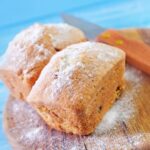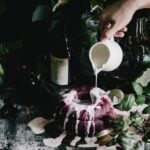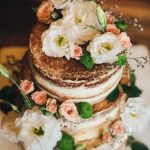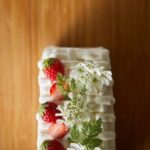How do you make icing for decorating a cake? Icing plays a crucial role in cake decoration, as it not only adds flavor but also serves as a canvas for creative and beautiful designs.
Whether you’re aiming for a simple and elegant finish or an intricate and colorful masterpiece, the right type of icing can make all the difference. In this article, we will delve into the world of cake decorating and explore the various types of icing, key ingredients, essential tools and equipment, step-by-step instructions for making buttercream icing, expert tips and tricks, common mistakes to avoid, and creative inspiration for achieving stunning cake finishes.
Icing comes in different forms, each with its own unique properties and uses. From the creamy richness of buttercream to the smooth versatility of fondant and the delicate beauty of royal icing, there’s an icing type suitable for every cake decorating need. Understanding the characteristics of each type is essential in achieving your desired cake decoration style.
In addition to exploring the types of icing available, we will also provide a comprehensive guide to the key ingredients needed for making successful homemade icing. This includes information on different types of sugar, fats, flavorings, and coloring agents that contribute to the overall texture and taste of your icing. Understanding these components is crucial in creating a delicious and visually appealing finished product.
Types of Icing
Buttercream, fondant, royal icing, and cream cheese frosting are the most popular types of icing for decorating cakes. Each type has its own unique characteristics and is best suited for different cake decorating techniques.
Buttercream is a versatile and easy-to-make icing that is perfect for spreading, piping, and creating intricate designs on cakes. Made with butter, powdered sugar, and flavorings such as vanilla or chocolate, buttercream can be tinted with food coloring to create vibrant colors for decorative purposes.
Fondant is a type of icing that is rolled out into a thin sheet and draped over the cake for a smooth and polished finish. It can also be used to create 3D decorations, intricate patterns, and realistic-looking shapes. Fondant comes in a variety of flavors and colors, making it a popular choice for professional cake decorators.
Royal icing is made from confectioners’ sugar, egg whites or meringue powder, and water. It dries hard and sets quickly, making it ideal for creating delicate decorations such as flowers, lacework, and intricate piped designs.
Cream cheese frosting has a tangy flavor that pairs well with carrot cake, red velvet cake, and other flavored cakes. It is creamy in texture and can be easily spread or piped onto cakes for a delicious finishing touch.
| Ingredient | Measurement |
|---|---|
| Butter | 1 cup (2 sticks), at room temperature |
| Powdered Sugar | 4 cups |
| Vanilla Extract | 1 tsp |
Once you have gathered your ingredients, start by beating the butter in a mixer until it becomes light and fluffy. Gradually add the powdered sugar to the mixture until it is fully incorporated. Finally, add the vanilla extract to give the buttercream its delicious flavor. Now you have a smooth and creamy buttercream that can be used to decorate your cake in any way you desire.
Ingredients
When it comes to making icing for decorating a cake, there are various types of icing that you can choose from. Each type has its own unique flavor, texture, and application method. However, all of them share some common key components that are essential for creating the perfect icing.
One of the main ingredients in most icings is confectioners’ sugar, also known as powdered sugar. This finely ground sugar dissolves easily and provides sweetness and structure to the icing. Another crucial component is butter or shortening, which adds richness and stability to the icing. Additionally, liquid such as milk, heavy cream, or water is used to adjust the consistency of the icing and make it spreadable or pipeable.
In some cases, flavorings such as vanilla extract, almond extract, or citrus zest are added to enhance the taste of the icing. Furthermore, food coloring can be used to achieve different colors for decorative purposes. Understanding these key components and how they work together is essential in creating delicious and visually appealing icing for cake decoration.
Tools and Equipment
When it comes to successful cake decorating, having the right tools and equipment is essential. Without the proper tools, achieving a professional-looking finish can be challenging. From piping bags to offset spatulas, there are several key items that every cake decorator should have in their arsenal.
Piping Bags and Tips
Piping bags are an essential tool for applying icing to a cake. They come in various materials, such as disposable plastic or reusable cloth, and can be fitted with different tips to create a variety of decorative designs. From simple round tips for creating borders to intricate petal tips for making realistic flowers, having a selection of piping tips is crucial for achieving different decorative effects.
Offset Spatula
An offset spatula is another indispensable tool for cake decorators. This long, flat spatula with a bent handle is used for spreading and smoothing icing on the surface of the cake. Its offset design allows decorators to easily reach the sides of the cake without their hand getting in the way, resulting in a smoother finish.
Cake Turntable
A revolving cake turntable makes the process of decorating a cake much easier. By placing the cake on a turntable, decorators can rotate it as they apply icing, ensuring even coverage and consistent design throughout the entire cake.
Having these essential tools and equipment at your disposal will make the process of decorating cakes with homemade icing much more enjoyable and successful. Whether you’re a beginner or an experienced decorator, investing in quality tools will greatly improve the outcome of your creations.
Step-by-Step Instructions
Buttercream icing is a versatile and delicious choice for cake decoration, offering a smooth and creamy texture that can be easily colored and piped onto cakes. Whether you’re a beginner or an experienced baker, mastering the art of making the perfect buttercream icing is essential for creating beautifully decorated cakes.
To make buttercream icing for decorating a cake, you will need the following ingredients: unsalted butter, powdered sugar, vanilla extract, and heavy cream. Start by creaming the softened butter in a mixing bowl until it becomes light and fluffy. Gradually add in the powdered sugar, mixing well after each addition to ensure a smooth consistency. Then, incorporate the vanilla extract for flavor and add just enough heavy cream to achieve the desired consistency for spreading or piping onto your cake.
One important aspect of making buttercream icing is achieving the right texture. The key to perfecting your buttercream is to strike a balance between stiffness for piping intricate designs and softness for spreading evenly on your cake layers.
If the icing is too stiff, it will be difficult to work with; if it’s too soft, it may not hold its shape when piped. Be sure to adjust the amount of powdered sugar and heavy cream accordingly as you mix the ingredients to achieve the ideal consistency.
In addition to basic buttercream, there are various flavor variations that can be easily incorporated into your icing such as chocolate, lemon, or raspberry. Experimenting with different flavors can add an extra layer of excitement to your cake decorations and allow you to customize your creations according to personal preferences or specific occasions.
Once you’ve mastered the art of making basic buttercream icing, don’t be afraid to get creative with different flavor combinations to take your cake decorating skills to the next level.
Tips and Tricks
Proper Consistency Is Key
When it comes to decorating a cake with icing, achieving the right consistency is crucial. If your icing is too runny, it will not hold its shape and your decorations may droop or slide off the cake. On the other hand, if the icing is too stiff, it will be difficult to pipe and create intricate designs.
To ensure the proper consistency, remember to gradually add liquid (such as milk or water) to your icing until you reach the desired texture. If you accidentally add too much liquid, simply mix in more powdered sugar until you achieve the right consistency.
Use Piping Techniques for Precision
For professional-looking cake decorations, consider investing in piping bags and various tips to achieve different designs. Some popular piping techniques include rosettes, swirls, shells, and writing. Practice using different tips and experiment with different pressures to control the flow of icing. Additionally, make sure to hold the piping bag at a consistent angle and apply even pressure for smooth and uniform designs.
Experiment With Color and Texture
Don’t be afraid to get creative when decorating with icing. Experiment with different food coloring options to achieve vibrant hues for your decorations. You can also incorporate texture by using tools like combs or spatulas to create interesting patterns on the surface of your cake. Adding sprinkles, edible glitter, or other decorative elements can also bring a unique touch to your cake design.
By following these expert tips and tricks, you can elevate your cake decorating skills and create stunning designs that are sure to impress. Whether you’re a beginner or seasoned baker, incorporating these techniques into your icing decoration process will help you achieve beautiful and professional-looking results every time.
Common Mistakes to Avoid
When working with icing for cake decoration, there are several common mistakes that can occur which can affect the overall appearance and taste of your creation. Here are some pitfalls to watch out for when working with icing:
1. Overmixing the Icing: When making buttercream or cream cheese frosting, overmixing can cause the icing to become too thin or lose its fluffy texture. It’s important to mix at a low speed and only mix until the ingredients are fully combined to avoid this issue.
2. Using Warm Tools: Room temperature tools are ideal for working with icing, as warm utensils can cause buttercream or fondant to melt or become difficult to work with. Be sure to chill your tools in the refrigerator before use to prevent this from happening.
3. Adding Too Much Liquid: When preparing royal icing, adding too much liquid can result in a runny consistency that is challenging to work with. It’s important to add liquid gradually and test the consistency often to achieve the desired thickness for piping and decorating.
4. Not Allowing Enough Time for Icing to Set: Whether you’re using buttercream, fondant, royal icing, or cream cheese frosting, it’s crucial to allow enough time for the icing to set before adding additional decorations or transporting the cake. This will help prevent smudging or drooping of the decorations.
By being mindful of these common mistakes and taking proactive measures to avoid them, you can ensure that your cake decorating experience is smooth and successful. With practice and attention to detail, you’ll be able to create stunning cakes with beautifully decorated homemade icing that will impress your friends and family.
Creative Inspiration
Decorating a cake with homemade icing offers a canvas for creativity, allowing for endless possibilities and decorative techniques. Whether you are a beginner or an experienced baker, it’s important to explore different ways to enhance the appearance of your cake using various methods and tools. Here are some creative inspiration and ideas for showcasing different decorative techniques that will help you achieve a stunning cake finish:
- Piping: Using piping bags and different tips to create intricate designs such as flowers, borders, and lettering on the cake.
- Fondant Toppers: Creating fondant shapes, figures, or cutouts to place on top of the cake for a whimsical or themed look.
- Stenciling: Using stencils to apply designs or patterns onto the surface of the cake using powdered sugar or icing.
- Painting: Using edible food colors to paint directly onto the icing surface for a hand-painted effect.
These decorative techniques can take your cake decorating skills to the next level and bring your creations to life. Experimenting with these methods will allow you to express your unique style and personality through your cakes. Whether you prefer a classic and elegant design or a fun and playful look, there are endless possibilities when it comes to decorating cakes with homemade icing.
Achieving a visually stunning cake finish requires patience, practice, and attention to detail. By exploring different decorative techniques and finding inspiration from various sources such as baking books, online tutorials, or even nature itself, you can elevate your cake decorating skills and create showstopping desserts that will impress family and friends alike. With dedication and creativity, mastering these decorative techniques will become second nature, allowing you to enjoy the process of transforming simple cakes into works of art.
Conclusion
In conclusion, decorating a cake with homemade icing not only adds a visually appealing touch to the dessert but also allows for a personal and creative expression. Whether it’s a simple birthday cake or an elaborate wedding centerpiece, the joy of crafting your own icing and using it to bring life to your bakes is unmatched.
From buttercream to fondant, royal icing, and cream cheese frosting, the options are endless, and by understanding the different types of icing, their ingredients, tools needed, step-by-step instructions, tips and tricks from experts, common mistakes to avoid, and being inspired by various decorative techniques showcased in this article can help elevate your cake decorating game.
The key question “How do you make icing for decorating a cake” has been thoroughly answered within the article. By following a few basic guidelines and experimenting with different flavors and textures, anyone can create beautifully decorated cakes that will surely impress friends and family. The process may seem daunting at first, but with patience and practice comes mastery. With dedication and determination, even amateur bakers can learn how to transform a plain cake into a work of art.
In the end, the satisfaction that comes from putting love and effort into creating something delicious and visually stunning is unparalleled. The joy in presenting a beautifully decorated homemade cake goes beyond taste; it reflects creativity, skill, passion for baking – all combining to make every celebration memorable through delightful sweet treats. So grab your mixing bowls and piping bags – let’s get started on making your next masterpiece.
Frequently Asked Questions
What Kind of Icing Is Best for Decorating Cakes?
The best kind of icing for decorating cakes is royal icing, as it hardens and holds its shape well. It’s ideal for intricate designs and piping details, making it a popular choice for cake decoration.
How to Make Icing for a Cake at Home for Beginners?
For beginners, making icing at home can be simple. A basic buttercream icing just requires butter, powdered sugar, vanilla extract, and a bit of milk. With the right proportions and mixing technique, you can create a smooth and creamy icing to use on your cake.
How to Make the Perfect Cake Icing?
To make the perfect cake icing, it’s important to start with the right consistency for the type of design you want to create. Whether it’s buttercream, royal icing, or fondant, achieving the ideal texture through proper mixing and adding liquid ingredients gradually is key to getting a smooth and easy-to-work-with icing.
Additionally, ensuring that your cake is completely cooled before applying the icing will help achieve a flawless finish.

Welcome to my blog about home and family. This blog is a place where I will share my thoughts, ideas, and experiences related to these important topics. I am a stay-at-home mom with two young children. I hope you enjoy reading it! and may find some helpful tips and ideas that will make your home and family life even better!





